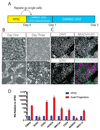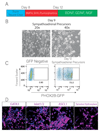Efficient Generation of Trunk Neural Crest and Sympathetic Neurons from Human Pluripotent Stem Cells Via a Neuromesodermal Axial Progenitor Intermediate
- PMID: 30688409
- PMCID: PMC6520238
- DOI: 10.1002/cpsc.81
Efficient Generation of Trunk Neural Crest and Sympathetic Neurons from Human Pluripotent Stem Cells Via a Neuromesodermal Axial Progenitor Intermediate
Abstract
The neural crest (NC) is a multipotent embryonic cell population that generates various cell types in an axial position-dependent manner. Cranial NC cells give rise to mesoectodermal derivatives, melanocytes, neurons, and glia whereas the vagal NC generates the enteric nervous system and trunk NC cells produce sympathetic neurons and neuroendocrine cells. An attractive approach for studying human NC biology and modeling NC-associated developmental disorders (neurocristopathies) involves the in vitro production of NC cells from human pluripotent stem cells (hPSCs). However, most conventional differentiation protocols generate predominantly cranial NC cells but fail to induce trunk NC cells. Here we describe a detailed protocol for the efficient in vitro generation of trunk NC cells and their derivatives from hPSCs. This relies on the induction of an intermediate cell population that exhibits neural and mesodermal potential, resembling the embryonic neuromesodermal progenitors, which generate the postcranial body axis in vivo. © 2019 by John Wiley & Sons, Inc.
Keywords: human pluripotent stem cells (hPSCs); neural crest; neuromesodermal progenitors; sympathetic neurons.
© 2019 John Wiley & Sons, Inc.
Figures




References
-
- Brown JM, Storey KG. A region of the vertebrate neural plate in which neighbouring cells can adopt neural or epidermal fates. Curr Biol. 2000;10(14):869–872. - PubMed
-
- Catala M, Teillet M-A, Le Douarin NM. Organization and development of the tail bud analyzed with the quail-chick chimaera system. Mech Dev. 1995;51(1):51–65. - PubMed
Publication types
MeSH terms
Grants and funding
LinkOut - more resources
Full Text Sources

